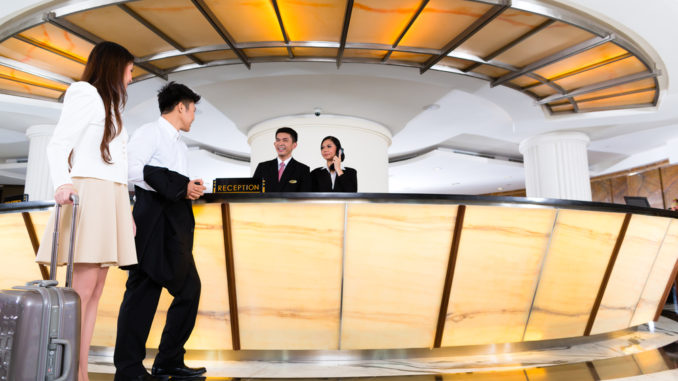
By Kelly Potter, Marketing Associate, Transcendent
It’s not surprising that facilities from various industries are diving into Augmented Reality (AR) as a tool to increase customer satisfaction and to increase their bottom line. One industry in particular is hospitality.
In recent years, Augmented Reality (AR) has emerged as a vital marketing tool, allowing businesses to change the way customers perceive the environment they are in. The technology is extremely valuable to the hospitality industry, because hotels are essentially selling a physical environment, which can be enhanced through AR.
Why is AR Becoming Important in the Hospitality Industry?
Augmented Reality has emerged as an important concept within the hospitality industry in recent years, because it allows hotels and other related businesses to enhance the physical environment they are selling (i.e. their hotel and its rooms), or enhance the experience of exploring the surrounding area.
Another of the key explanation is the amount of information guests tend to ask for, both before they arrive and once they are there. Augmented reality technology can make a lot of this information readily available to customers at all times of the day, improving their entire experience.
Augmented Reality can be seen as a two-fold in the hotel industry as a front-of-the-house application and a back-of-the-house application integrated with other technologies, like an EAM CMMS mobile application.
Here are a few examples of how guests use AR technologies as a front-of-the-house concept and integration.
- Interactive Hotel Rooms – The ability to see a map of the interior of a room before check in which has been used in UK hotels.
- Augmented Hotel Environments – Hotels are looking for ways to entertain their guests while on property other than the typical activities (pool/recreation). For example, Holiday Inn created an AR hotel experience, which allowed guests to point their smartphone and see realistic virtual depictions of famous celebrities in the hotel.
- Beacon Technology – Example: Starwood Hotels used the technology to send virtual keys to guests, allowing them to unlock their door through their phone. This can also be found at Disney Resorts in Orlando, FL where once you check in using their My Disney Experience app you can choose to lock/unlock your door with your smartphone on day of check in.
AR Applications & Hospitality Integration for Workers

In order for the front of the house to operate properly, the back of the house needs to have applications that will keep customer satisfaction high, keep costs down for hotels, and ultimately keep the assets of the property in tact and in working fashion.
Facility managers are constantly thinking of ways to increase productivity, decrease costs, and keep engineers safe while they perform work tasks. Augmented Reality is a great example of how engineers/workers can use these tools and incorporate them with an EAM CMMS solution.
Some industries are already incorporating AR technology into their day to day tasks to increase worker/engineer knowledge, ramp up the on-boarding time for new employees, and keeping engineers safer by seeing instructions in real-time on real objects.
A company called DAQRI is focused on AR technology and developed a wearable AR tech smart helmet for industrial use. Engineers can see 4D images above assets in their facilities that prompt them with instructions and also give them a mapping of all asset functionality. This wearable technology allows engineers to discover asset information faster and closes the knowledge gap for new hires.
Another company called UpSkill connects the workforce through Augmented Reality in its wearable technology guiding technicians in real-time to complete tasks, checklists, work orders, and send media to managers.
Finally, a company called Worklink has made it possible for users to create their own smart instructions for assets to allow for less human error, increase safety, and also walk engineers step-by-step on repair processes. This can increase the time it takes to complete work by also complying with facility procedures.
This equipment is becoming more prevalent and as more machines become connected to the internet, “approximately 50 billion machines will be connected on the internet by 2020” it becomes imperative facilities and industries adopt these devices and make them apart of their facility operations.

A CMMS has the capability to provide maintenance management and staff with an automated tool capable of scheduling inspections, preventive maintenance, managing inventory, work orders, and retrieval of recorded asset history.
Technicians can perform actual work with instructions on handhelds, enter how long it takes to complete work orders, filter through past work orders, and close out of the system. All the information is recorded in real-time, so managers can access the information instantaneously.
The ability to track your work, document it, and send it to managers could be paired with wearable technology, like the companies above, to get engineers an elevated view of assets through thermal technology or the ability to see instructions on assets and use that data to train new hires and not have to worry about on-boarding.
A CMMS could also benefit from machine learning using algorithms to monitor assets like meter readings and the ability to calculate readings by the second which would be humanly impossible to do; this will cut down on extraneous labor costs and allow facilities to allocate dollars elsewhere.
The possibilities are becoming endless when it comes to how IoT, AR, VR, and Machine learning can help facilities with energy savings, labor savings, employee safety, and more. The future is a scary and exciting thing but ultimately inevitable for change.
Kelly Potter is marketing associate at Transcendent, an operations management software providing customer, employee, and asset information beyond the traditional office.
Are you an industry thought leader with a point of view on hotel technology that you would like to share with our readers? If so, we invite you to review our editorial guidelines and submit your article for publishing consideration.
